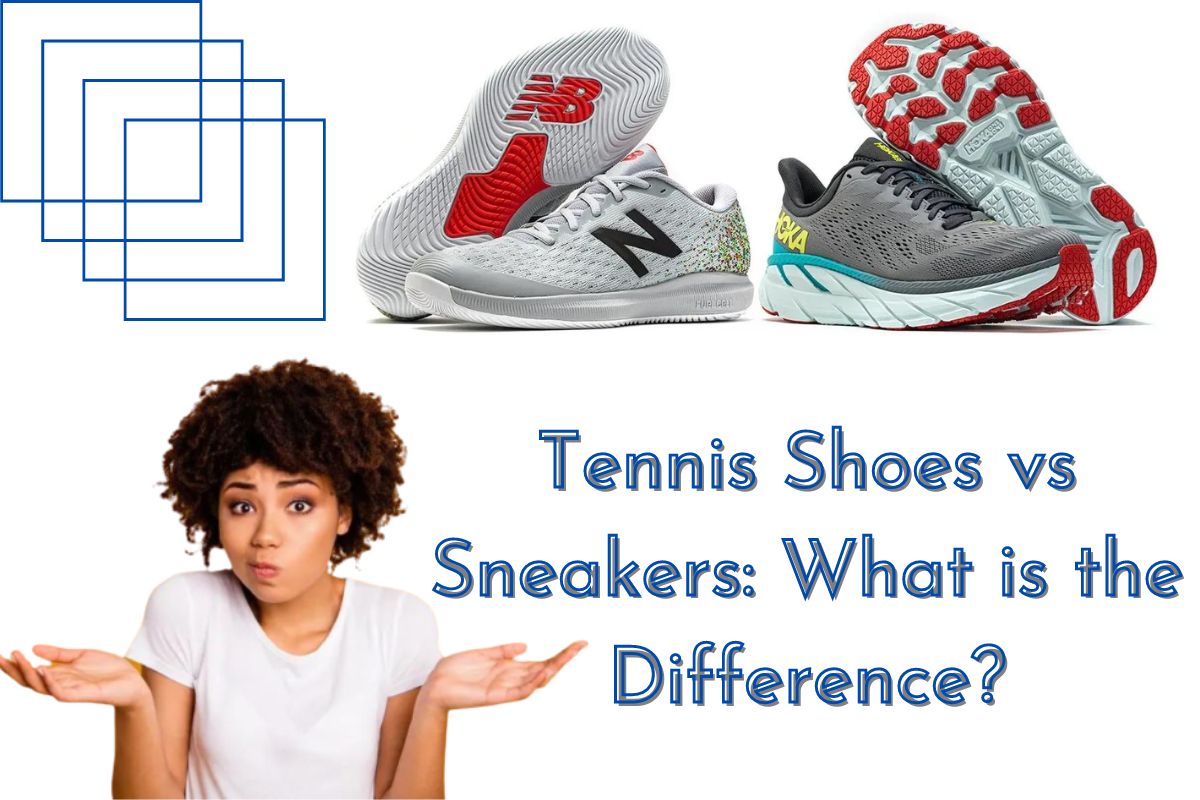We’ve all heard of terms that are frequently used interchangeably. Despite their similar
meanings, these terms do not have the same definition. Tennis shoes and sneakers are
often used interchangeably, even though they are two different types of shoes.
Although many people mix the phrases tennis shoes and sneakers, you may be surprised to
learn that they have different meanings. There is no shame in not understanding the
difference. However, if you want to know the definitions of these two types of shoes, then
this article is just for you. In this article, we will explain the distinctions between running shoes
and tennis shoes, when to wear them, and much more for those who are interested.
What are Sneakers?
We’ve probably all heard the term “sneakers” and understand what it means, especially
those of us who adore this sort of shoes.
The sneaker comes from the word sneak, which translates to go stealthily, which is also
related to stealing. Thieves were known as sneaks. The only oddity was that shoes
back then were mostly made of leather, so walking around in them was noisy, so going
unnoticed was out of the question. Things changed when the first rubber-soled shoes
appeared in the 19th century, which became the perfect choice for silent walking. From this,
the term “sneaker” was born.
What are Tennis Shoes?
Tennis shoes differ from athletic shoes as they are designed to enhance and complement
tennis players’ performance. The tennis shoes are equipped with a low, wide rubber sole for
quick lateral movements and changes of direction. This feature helps prevent sprained
ankles.
Tennis players also tend to wear out the toes of their shoes for the same reasons, so the
toes of many tennis shoes are reinforced with additional rubber or other material.
Difference between Sneakers and Tennis Shoes
Sneakers and tennis shoes are often used interchangeably, but there are some important
differences between the two types of shoes. Sneakers are often made from lighter, more
breathable materials and have a rubber sole designed for flexibility and grip. Tennis shoes,
on the other hand, are usually made from heavier materials, such as leather or canvas, and
have a thicker sole that offers more support and stability to provide traction on the pitch.
While both sneakers and Tennis shoes can be worn for casual wear, sneakers are generally
considered more comfortable, while tennis shoes offer more support and protection during
sports.
The main difference between tennis shoes and sneakers is the purpose of their design.
Sneakers are generally designed for walking and running, while tennis shoes are primarily
designed to be worn on a tennis court.
● History
Goodyear began manufacturing the first rubber-soled shoes in the 1880s under the Keds
name. These shoes were later called sneakers because they were exceptionally quiet on all
surfaces, and you could sneak away in them.
In 1931 Adidas launched its first tennis shoe and Converse followed with the introduction of
the Jack Purcell tennis shoe. Since then, tennis shoes have specialized in the game of tennis.
Sneakers became more popular among teenagers and rebels after the 1950s and became
more important and popular in sports like basketball and soccer. The sneaker grew in
popularity and became both a practical sporting necessity and a fashion statement.
● Material
The most common materials for modern shoes are fabrics, rubber, foam, and plastic.
Nowadays, lightweight, breathable, and waterproof shoes are used by people. However,
shoes are generally made from thicker synthetic materials.
● Structure
Essentially, it’s the looks that sets one apart from the other. An athletic shoe with a canvas
upper is classified as a pair of sneakers, and anything designed more for a specific sport or
activity is classified as an athletic shoe, a such as tennis shoe.
If you look at runners, you’ll see that the design of their “gum trainers” or running shoes is
more geared towards improving the performance of the person wearing them. Sports shoes
are considered more fashionable. This may vary as sneakers are more fit for purpose than
such shoes and not for their looks and physical design.
● Cushioning
Cushioning in a shoe is its ability to absorb the force of an impact to minimize the inevitable
impact on the ground. Both sports and athletic shoes need good cushioning to maximize
their performance. Runners are more likely to risk serious injury than humans as their foot
suddenly lands on the ground with huge force. Therefore, these shoes have much more
cushioning than sports shoes.
● Cost
The cost of shoes and sneakers depends on the innovative technology developed for the
shoe, brand, and model. Inexpensive shoes have lower-quality rubber soles, less
complicated stitching, and little to no air in the soles. Mid-range sneakers, which usually
advertise special technologies or comfort additives, cost more.
Because tennis shoes must meet certain requirements to be court-ready, the budget range
tends to be higher than sneakers. In the high-end segment, tennis shoes and sneakers are
advertised as special or limited models.
● Weight
When comparing tennis shoes to sneakers, consider their weight. Tennis shoes, crafted for sports, are lightweight for agility. They excel in quick and dynamic movements. Sneakers, a diverse category, vary in weight based on style and purpose. Recent trends favor lightweight and breathable designs, meeting demands for versatile footwear. In conclusion, tennis shoes prioritize lightness for sports, while sneakers offer options catering to diverse consumer preferences.
● Durability
Tennis shoes and sneakers differ in durability based on their original purposes. Tennis shoes, designed for sports like tennis, prioritize durability to handle specific movements. They use sturdy rubber outsoles for court traction and abrasion-resistant upper materials.
Sneakers, a broader category for athletic and casual wear, vary in durability. Some focus on style and comfort, more suitable for casual use than intense sports. Recent trends blend the lines, with brands enhancing casual athletic sneakers for both daily wear and sports. Consumers should consider the shoe’s design and intended use for durability.
● Availability
Availability is crucial for tennis shoes and sneakers. Despite the tennis shoe name, they’re easily found in various stores, from sports outlets to regular shops. Major athletic brands produce them, catering to both sports and casual wear.
“Sneakers” is a broader term, covering various casual athletic shoes suitable for different activities. Thanks to their popularity, sneakers are widely available – in department stores, specialty shops, and online. The term reflects diverse styles, adapting to various lifestyles and fashion trends.
Read Also: Top Tips to Boost Your Content Marketing
Conclusion
The bottom line is that sneakers and tennis shoes are designed for different purposes. If you
are looking for a good pair of shoes to wear when playing tennis, then you should invest in a
pair of tennis shoes. On the other hand, if you are just looking for a comfortable pair of shoes
to wear every day, sneakers will suit you better.
It is important to choose the type of shoes correctly. When deciding what type of shoes to
buy, you should keep in mind- whether you want to wear them while walking or shopping, or
whether you want to engage in a specific type of exercise or activity. It is essential that you
Frequently Asked Questions:
- What’s the difference between a sneaker and a tennis shoe?
The terms “sneaker” and “tennis shoe” are often used interchangeably, but some people argue that “tennis shoe” specifically refers to athletic shoes designed for sports like tennis, while “sneaker” is a broader term encompassing various casual athletic shoes. - Can tennis shoes be used as sneakers?
Yes, tennis shoes can be considered a type of sneaker, as the term “sneaker” is a more general category that includes various types of athletic shoes designed for casual wear. - Why do we call sneakers tennis shoes?
The term “tennis shoes” originated because athletic shoes were initially designed for specific sports like tennis. Over time, the term “sneaker” gained popularity as a more inclusive and general descriptor for casual athletic footwear. - Can I wear tennis shoes every day?
Yes, you can wear tennis shoes every day if they are comfortable and suitable for your daily activities. Many people choose athletic or casual shoes, including tennis shoes, for everyday wear due to their comfort and versatility.
- What Is E-Tender? - November 23, 2022
- Tennis Shoes vs Sneakers: What is the Difference? - November 18, 2022
- Where And How To Get The Right Reviews For Your Business - September 17, 2022




